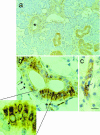Intralobular ducts of human major salivary glands contain leptin and its receptor
- PMID: 12448771
- PMCID: PMC1570946
- DOI: 10.1046/j.0021-8782.2002.00106.x
Intralobular ducts of human major salivary glands contain leptin and its receptor
Abstract
Leptin, a 16-kDa hormone, plays an important role in the control of food intake and in energy homeostasis both in rodents and in man. Leptin is mainly produced and secreted by adipocytes, but other tissues and gastric glands have also recently been shown to produce it in a dual (endocrine and exocrine) mode. In addition, a leptin receptor has been detected in taste cells of mouse circumvallate papillae and in rat intestinal epithelium. These data prompted us to carry out a detailed study of human salivary glands as potential leptin-producing organs. Biopsies of salivary glands (submandibular and parotid) obtained from male and female patients during surgery for different clinical indications were subjected to immunohistochemical study for the presence of leptin, its functional receptor, insulin and glucagon. The presence and cellular distribution of glucocorticoid receptor in leptin-secreting cells were also investigated. Double immunohistochemical staining (silver-gold intensification and avidin-biotin-peroxidase) was used for the visualization of glucocorticoid receptor and leptin labelling, respectively. The results show that intralobular duct cells of submandibular and parotid glands are immunoreactive for leptin, leptin receptor and glucagon but not for insulin. Leptin was also detected in some microglobules in whole saliva obtained from four healthy volunteers. Co-localization for leptin, leptin receptor and glucocorticoid receptor in the same cell type suggested a functional relationship between glucocorticoid hormone and leptin secretion also at the level of the salivary glands.
Figures


References
-
- Adcock IM, Gilbey T, Gelder CM, Chung KM, Barnes PJ. Glucocorticoids receptor localization in normal and asthmatic lung. Am. J. Respir. Crit. Care Med. 1996;154(3 Part 1):771–782. - PubMed
-
- Antakly T, Eisen HJ. Immunocytochemical localization of glucocorticoid receptor in target cells. Endocrinology. 1984;115:1984–1989. - PubMed
-
- Antakly T, Zhang C, Sarrieau A, Raquidan D. Cell-specific expression of the glucocorticoid receptor within granular convoluted tubules of the rat submaxillary gland. Endocrinology. 1991;128:617–622. - PubMed
-
- Bado A, Levasseur S, Attoub S, Kermorgant S, Laigneau JP, Bortoluzzi MN, et al. The stomach is a source af leptin. Nature. 1998;394:790–793. - PubMed
-
- Barka T. Biologically active polypeptides in submandibular glands. J. Histochem. Cytochem. 1980;28:836–859. - PubMed
Publication types
MeSH terms
Substances
LinkOut - more resources
Full Text Sources
Molecular Biology Databases
Miscellaneous

